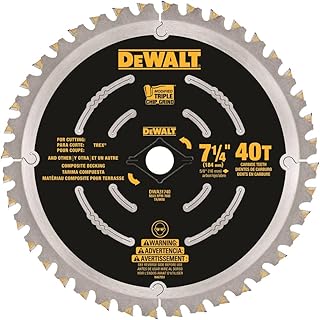When working with Trex or other composite decking, choosing the best saw blade for cutting Trex decking is essential. Why? Because the wrong blade can leave rough edges, burn marks, or even damage your boards. If you’ve ever wondered about the best saw blade for cutting vinyl siding or the best saw blade for cutting plastic, you already know that blade choice makes all the difference. The same rule applies here.
But what about the right saw? Which tooth count should you pick? And what if you’re comparing different tools among the best saws available today? Stick around—we’ll break it down step by step.
Top Picks
Best Composite Cuts: Makita E-12217 EFFICUT Composite Decking Circular Saw Blade Diameter
The Makita E-12217 EFFICUT Circular Saw Blade is engineered for cutting natural fiber-reinforced plastics such as WPC, making it a solid choice for decking projects. With a 165 mm diameter, 24 teeth, and a 15° tooth angle, it delivers fast and accurate cuts while maintaining efficiency on cordless hand circular saws. Its lightweight build reduces strain, and the design is optimized to extend battery runtime without sacrificing cut quality.
From a customer perspective, the blade is praised for clean and smooth cuts on composite decking, reducing splintering and material waste. Professionals note that it balances durability with precision, though it is limited in versatility since it is not suitable for metals or harder materials.
Overall, this saw blade provides excellent performance for composite applications, offering strong value for users seeking efficiency, precision, and reliability in decking projects.
Best Fine Cuts: Diablo High-Performance Finish Trim Saw Blade
The Diablo D0641X Circular Saw Blade by Freud is built with 40 teeth and a 6.5-inch diameter, designed to deliver exceptionally fine and clean cuts in wood. Its thin kerf construction ensures fast cutting with minimal material waste, while the lightweight design makes it easy to handle and reduces motor strain. The brushed finish enhances durability, and Freud backs the blade with a limited lifetime guarantee for added confidence.
Customers appreciate the blade’s ability to produce smooth edges with little tear-out, making it ideal for finish carpentry and precision woodworking. Professionals highlight its balance between performance and affordability, though its design is best suited for specific wood applications rather than heavy-duty or multi-material use.
Overall, the Diablo D0641X offers strong value for anyone seeking accuracy and clean results in woodworking projects, standing out as a dependable option for fine finishing tasks.
Best Efficiency: Makita E-12223 EFFICUT Composite Decking Circular Saw Blade
The Makita E-12223 EFFICUT Circular Saw Blade features 40 tungsten carbide teeth and a 165 mm diameter, engineered for smooth and efficient cutting performance. Its lightweight build reduces strain on cordless hand-operated saws while enhancing battery life. The precision tooth design ensures accurate cuts with less resistance, making it well-suited for wood and composite applications.
From a customer perspective, the blade is valued for its sharpness and ability to maintain performance over time. Professionals highlight the balance between speed and cut quality, noting that it excels in decking and general woodworking but is not intended for harder or metallic materials.
Overall, the Makita E-12223 provides strong cutting efficiency, durability, and reliability for woodworking and composite projects, making it a smart choice for both professionals and DIY users.
FAQs
Do you need a special blade to cut Trex decking?
Yes, you do. Trex is made from a mix of wood fibers and plastic, which makes it denser than natural wood. A standard wood-cutting blade may tear or splinter the surface. For best results, use a carbide-tipped blade specifically designed for composite or non-ferrous materials. These blades stay sharper longer and deliver smooth, burn-free cuts.
What saw do you use to cut Trex?
The type of saw depends on your project. A circular saw works well for straight cuts, while a miter saw is perfect for angled cuts on deck borders. For notching or intricate shapes, a jigsaw with a fine-tooth blade is more effective. The key is using a saw with enough power and pairing it with the correct blade designed for composites.
What blade is used to cut composite deck boards?
For composite decking like Trex, a carbide-tipped blade with 40 to 60 teeth is the standard choice. A thin kerf design reduces resistance and ensures cleaner cuts. Blades with alternate top bevel (ATB) or triple chip grind (TCG) tooth patterns perform especially well, as they minimize chipping and extend blade life when cutting dense materials.
How many tooth saw blade for composite decking?
The ideal tooth count is between 40 and 60 teeth for circular saws, depending on the blade size. A 7-1/4 inch blade with 40 teeth provides a balance of speed and cut quality. If you want an ultra-smooth finish on visible edges, a 60-tooth blade will give better results, though it may cut more slowly. The goal is to balance efficiency with precision.
Conclusion
Choosing the best saw blade for cutting Trex decking comes down to using a carbide-tipped blade with the right tooth count and saw type. A 40-tooth blade works well for most projects, while a higher-tooth blade ensures finer edges. Pair it with a reliable circular or miter saw, and you’ll get clean, professional results without damaging your composite boards. With the right setup, your deck project becomes smoother, faster, and far more precise.






















